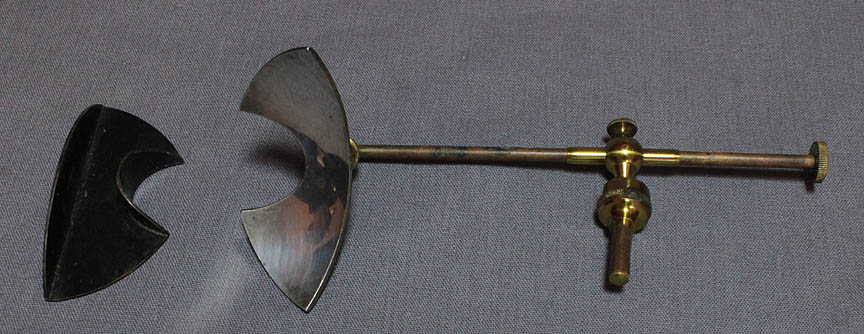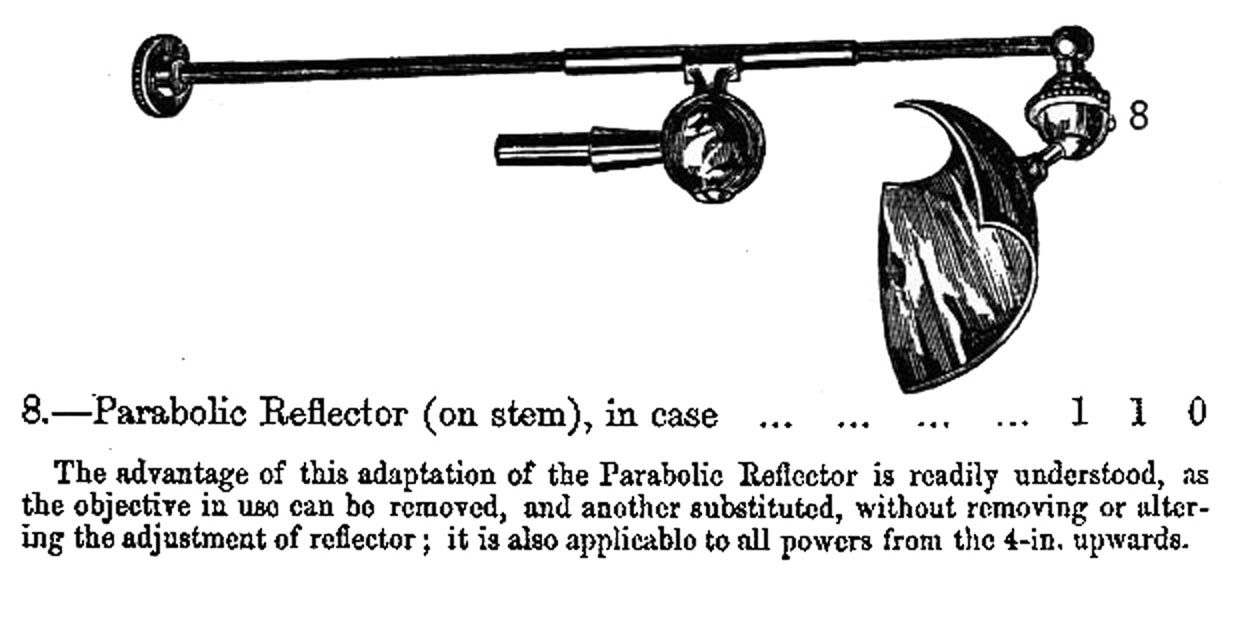COMPOUND BAR-LIMB MICROSCOPE WITH A 'CAPTAIN PERRY' ARM
MAKER:SWIFT
MODEL: 'PRESENTATION MICROSCOPE'
PLEASE SCROLL DOWN FOR MORE IMAGES
c.1877
THE SWIFT PARABOLIC STAGE REFLECTOR:

 The parabolic stage reflector is a device for concentrating light around an opaque object using a low to moderately high power objective. With moderate power objectives, the focal length is too short to allow ordinary reflected or concentrated lighting. The shape of the reflector concentrates the light, allowing observations of opaque objects using a higher power objective than would otherwise be feasible. Note that the example shown here has an extra feature of a knob to fix the position of the rod on the holder. Also instead of a simple rotating joint in the middle it has a universal ball joint there just as at the distal end; this would be an improvement over the simpler joint pictured in the engraving. This system will not work for the highest power objectives however. In those cases a
vertical illuminator is required. The parabolic reflector is silvered and has a blackened cap to protect the silver surface when not in use.
The parabolic stage reflector is a device for concentrating light around an opaque object using a low to moderately high power objective. With moderate power objectives, the focal length is too short to allow ordinary reflected or concentrated lighting. The shape of the reflector concentrates the light, allowing observations of opaque objects using a higher power objective than would otherwise be feasible. Note that the example shown here has an extra feature of a knob to fix the position of the rod on the holder. Also instead of a simple rotating joint in the middle it has a universal ball joint there just as at the distal end; this would be an improvement over the simpler joint pictured in the engraving. This system will not work for the highest power objectives however. In those cases a
vertical illuminator is required. The parabolic reflector is silvered and has a blackened cap to protect the silver surface when not in use.
Many authorites, including Hogg, in 1867, credit Beck with being the first to produce this type of reflector, specifically for Sorby. Note that it differs from the ordinary side reflector of Ross in that the Ross reflector has a spherical curve unlike the parabolic curve of this device. Sorby later modified this device to add a swing-out piece holding a directly reflecting mirror to allow the user to compare the obliquely lit image with the directly illuminated one. This device can be attached to one of the holes on either side of the top plate of the stage, or to the hole on either side of the limb; it seems be easier to position when attached to the limb.

 The parabolic stage reflector is a device for concentrating light around an opaque object using a low to moderately high power objective. With moderate power objectives, the focal length is too short to allow ordinary reflected or concentrated lighting. The shape of the reflector concentrates the light, allowing observations of opaque objects using a higher power objective than would otherwise be feasible. Note that the example shown here has an extra feature of a knob to fix the position of the rod on the holder. Also instead of a simple rotating joint in the middle it has a universal ball joint there just as at the distal end; this would be an improvement over the simpler joint pictured in the engraving. This system will not work for the highest power objectives however. In those cases a
vertical illuminator is required. The parabolic reflector is silvered and has a blackened cap to protect the silver surface when not in use.
The parabolic stage reflector is a device for concentrating light around an opaque object using a low to moderately high power objective. With moderate power objectives, the focal length is too short to allow ordinary reflected or concentrated lighting. The shape of the reflector concentrates the light, allowing observations of opaque objects using a higher power objective than would otherwise be feasible. Note that the example shown here has an extra feature of a knob to fix the position of the rod on the holder. Also instead of a simple rotating joint in the middle it has a universal ball joint there just as at the distal end; this would be an improvement over the simpler joint pictured in the engraving. This system will not work for the highest power objectives however. In those cases a
vertical illuminator is required. The parabolic reflector is silvered and has a blackened cap to protect the silver surface when not in use.